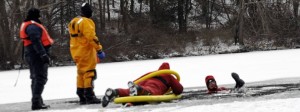Rescuing victims in the water

The Reach-throw-row-go approach is as follows:
- If the victim is within reach and rescuers are securely anchored on a vessel, extend your arm or a long object which can be grasped by the victim such as a pole or a long stick and pull the victim safely towards you.
- If the victim is far from reach, throw anything that floats within the victim’s range such as a life jacket or a throw line.
- If the victim is out of throwing range and rescuers are onboard a boat or vessel, row towards the victim and pull him/her out of the water and into the floating vessel.
- If none of the abovementioned procedures is feasible and if you are trained in water saving procedures only then must you risk jumping in the water to attempt in saving the victim.
Rescuing victims trapped on freezing water/ice
If a person has fallen in an icy body of water such as a frozen lake or pond near the shore:
- Extend a long stick/pole or throw a line with a floatable object attached to it which the victim can use to stay afloat. When the person has good hold of the object, pull him/her towards the shore or near the edge of the ice.
- Do appropriate care for hypothermia.
Electrical Emergency Rescue
Most indoor electrocution accidents are caused by faulty electrical wiring/equipment or simply by careless/inappropriate use of electrical appliances.
- Before attending to the victim, make sure to turn off the electricity at the circuit breaker, fuse box or outside switch box.
- If the electrocution involves high-voltage power lines, the power must be turned off prior to attending to the victim. Wait for trained personnel with proper equipment to safely cut or turn off wires.
- If live power lines have fallen over a vehicle, tell the driver and its passenger to stay still inside their vehicle. A victim should only attempt to jump out of the vehicle if an explosion or fire threatens to engulf the vehicle. Moreover, instruct the victim not to come in contact with the car or wire and the ground at the same time to prevent electrocution.
- Do not approach the victim in a puddle or pool of water containing a downed power line since water is a strong conductor or electricity.
Hazardous Materials Incidents
Nearly all highway crash scenes involve the possibility of spillage of hazardous chemicals both fluid as well as gases. Clues that indicate the possible presence of hazardous materials include visible signs on vehicles (explosive, flammable and corrosive), spilled liquids and solids, clouds of vapor, noxious fumes and unusual odors.
Rescuers on the scene should instruct people near the crash site to move away from the area. Only people who are specially trained with proper equipment should first clear the area for people and contain the spill as quick as possible to prevent further contamination to other areas.

